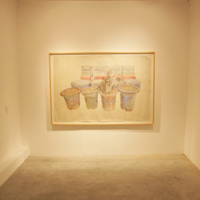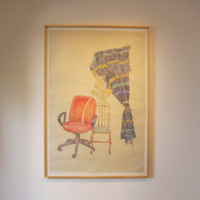| |


|
2012
August 30th to October 27th - Two in Thrones´room | Fernanda Chieco
Tangles What does this rabbit stare at? Where the fixed observation of this vulture is driven to? Some of the possible answers have to do with who sees those figures, that can face the large-scale drawings created by Fernanda Chieco - now on the single exhibition Duas na Sala do Trono/Two in the Throne Room held at Eduardo Fernandes Gallery - as a mirror, a gateway or even a jail or cage. “The thing is that vision always collides with the ineluctable volume of human bodies”. [...] And here comes the obsessive question: when looking at something before us, why does another thing look at us, imposing an in, an inside?”1, questions Georges Didi-Huberman, French theorist. The rabbit and the vulture, both protagonists in the two pieces, constitute the driving force of the new series by Chieco, together with the octopus, the piglet, the penis-fish, the monster-fish, the puffer, the ray, the lamb, the fish skeleton and even a small tree and a teddy bear. Admittedly, the look of the two characters now presented defies more emphatically those who watch them. More synthetically in the exhibition room, Coelho/Rabbit(2012) and Urubu/Vulture (2012) enhance senses previously touched by this artist from São Paulo in Trono de Pescador/Throne of Fisherman, exhibition staged at Paço Imperial in Rio de Janeiro, until early August. Displayed at Sala das Princesas and Sala Luis de Vasconcelos, the ten drawings of Trono de Pescador showed only dead animals, characters portrayed with tubes, wires and tubules which could no longer make life possible, such as actors in a narrative that ended in itself. Today, in Duas na Sala do Trono, the animals impose us, albeit in a melancholic manner, other clashes and relations. As strong as the rabbit and the vulture are the elements found in discarded household furniture, which acquire new status in the artist’s compositions. Chieco conceived such pieces when in residence in South Corea. In the country that was called “Asian Tiger” due to the economic growth that began specially during the ‘90s, this woman from São Paulo was surprised by the lots of chairs, armchairs, sofas and containers abandoned on the corners, intersections and waste lands. Displaced from their initial functions, the objects cause frictions on the regular fabric of the Asian metropolis, such as an attest of memory residue that insists on staying, indicator of a space in continuous, and not always positive, transformation. ‘Walking is one of our ultimate spaces of intimacy’, he says [Francis Alÿs]”2, points out Nicolas Bourriaud in Radicante, reinforcing the moving character of the contemporary artist, an aspect in which Chieco may be affiliated. And the artist [Chieco] ranges from an ambulatory feature through daily paths and the anchor in a holder marked by rigidity and resistance. The colored pencil is permanently inscribed on hanji, a Korean paper used by Chieco as a particular surface for her traits. Colors varying from beige to yellowish and the dense and intricate network of fibers make up the drawing, with no sketches. “Wrong? Throw it away”, says the artist, who needs to adapt the compositions to the predetermined cut of the material – since it is not sold in rolls, but sheets and the stores that sell them emphasize on ads their durability of more than 1,000 years. Thus, the poetic of Chieco rests on contemporary shifting concerns, questioning the logic of unrestrained consumption and giving new shape to procedures that could be handmade or anachronistic. As Argan has already warned in História da Arte como História da Cidade: “We have no difficulty in admitting that the city, in the broadest sense of the term, can be considered a consumer good [...]. It is, in short, to maintain or establish an individual’s ability to interpret and use the urban environment differently from the requirements implicit in the project of who determined it; finally, to give one the opportunity to not assimilate, but affectively respond to the environment. [...] This is the opening that the modern city should allow: from the achievement, the hardness of things to mobility and changeability of images”3. Moving and mutable, the work of Fernanda Chieco always reformulating the questions: What do we see? What sees us? Mario Gioia 1. DIDI-HUBERMAN, Georges. O Que Vemos, O Que nos Olha. São Paulo, 34, 2010, p. 30 2. BOURRIAUD, Nicolas. Radicante. São Paulo, Martins Fontes, 2011, p. 96 3. ARGAN, Giulio Carlo. História da Arte como História da Cidade. São Paulo, Martins Fontes, 1995, p. 219 e 220 |